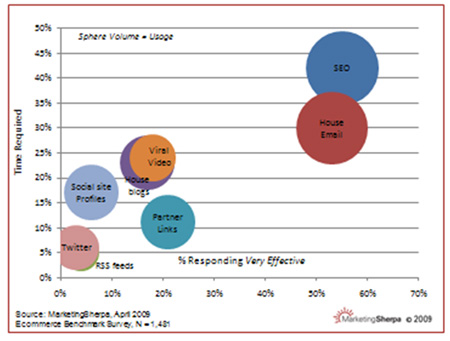Here’s a question most marketers are grappling with today: Which marketing strategies are getting the buzz and which ones are getting the real gains?
To find the answers, we teamed up with MarketingSherpa’s Research Director, Stefan Tornquist, for our May 27 web clinic on optimizing ecommerce sites.
Using a mix of new research and case studies, we identified tactics, channels, and test strategies that are increasing conversion rates and revenue for a variety of companies. We also explored how you can tap into elusive sources of ROI by going the extra step with your metrics and analysis.
[Editor’s Note: Unfortunately, a tech snafu with our webinar provider resulted in a gaping void where our standard audio and full video presentations would be. However, this research brief aims to convey the key points, research and takeaways from the session. You can also access more research data in the new 2009 MarketingSherpa Ecommerce Benchmark Guide, from which these charts were taken.]
How did we get to this point?
The following chart contrasts the year-over-year growth from the fourth quarters of 2007 and 2008. Most marketers won’t be surprised by the confirmation that growth was down significantly.
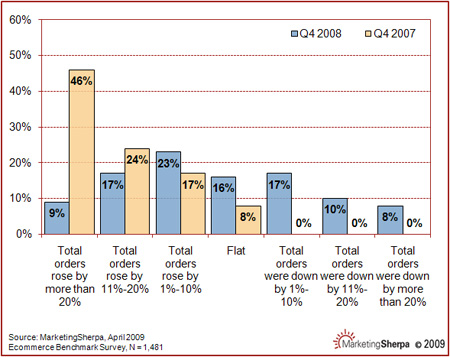
In 2008, fewer than 10% of marketers surveyed reported the strong 20% growth common in 2007. Where none of the companies surveyed in 2007 acknowledged drops in total orders, in 2008, 35% of the companies saw a decrease in total orders.
However, there is optimistic news to balance those drops. Nearly half of the companies recently surveyed confirmed that they are either growing or stable. While the growth might be more moderate in nature, the numbers indicate that growth remains even in tough conditions.
The response to these changes in some ways mirrors the survey: as some marketers are reining in their spending, others see an uncertain economy as a time to push their marketing efforts further.
Marketing optimism remains high overall
The next chart demonstrates the change in budget attitudes, depending on product type and organization size.

In a recent article in The New Yorker, writer James Surowiecki examined two ways companies can respond to economic downturn by contrasting the strategies of Post and Kellogg’s cereals during the Great Depression. Post reined in its expenses and cut back on advertising while Kellogg “doubled its budget.” By 1933, even with the economy at its worst, Kellogg could report steadily rising profits.
This anecdote, and the rest of Surowiecki’s article, supports the 2009 Ecommerce Benchmark Survey’s assertion that “a recession creates conditions which favor companies that choose to invest.”
There are several reasons to explain why increasing spend during a downturn can be the responsible choice:
- Advertising space is plentiful and affordable
- Strong brand presence creates consumer confidence, and
- There is less competition from more budget-conservative organizations
However, increased opportunity does not mean that marketers should deploy increased budgets on trendy channels. A sound strategy supported by fewer dollars will be more effective than spending generously on the next big thing, including technologies or trends that may or may not be the best fit for your goals or organization.
Social media is here, but the ROI isn’t just yet…
Sherpa asked consumer products and services marketers to rank their primary traffic drivers. As this chart shows, SEO and house email lists are clearly the strongest performers for ecommerce marketers.
Social media doesn’t yet come close to competing with search or email in terms of effectiveness. But marketers are still asking themselves whether that is because social media is ineffective or simply because, despite the hype, a huge percentage of people online aren’t actively or regularly engaged with social media sites and channels.
So, to boost ROI in this tight economy, should marketers keep forging ahead with these relatively new channels, or focus more on optimizing their proven channels?
The answer largely depends on how hard you want to fight for significant gains.
In our first case study, we reviewed one of the mainstays of ecommerce marketing: changes made to the subject line of a house email list.
Case Study #1: Thank-you email
Background:
Large florist with a strong online presence seeking to increase the effectiveness of a “Thank you” email campaign to previous customers.
The challenge:
To increase the rate of return business from customers who made recent purchases.
The goal:
To identify which email subject line will result in the greatest volume of return business.
We conducted an A/B split test using two different subject lines.
The control:
Subject Line #1 – Thank You For Making Us Your Florist Of Choice
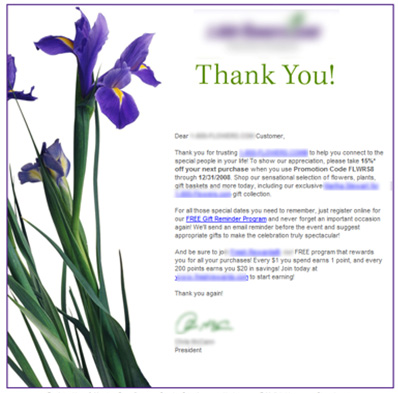
Analysis:
The burden of communication in customer appreciation emails involves sharing your intention to commend or thank the customer in a way that does not irritate the customer with additional unwanted email.
In this case:
- The letter format adds a personal touch
- Multiple calls to action in the email body offer customers an incentive: 15% off with promotion code and link to “Free Gift Reminder program” and link to Rewards program
- “Thank You For Making Us Your Florist of Choice” states intention of appreciation but does not make a clear offer
Let’s look at the second subject line…
Treatment: Subject Line #2 – 15% Off – Our Way Of Saying Thank You!

Analysis:
As demonstrated in the two screenshots, nothing changed in this email but the subject line.
- Email graphic and body copy are unchanged.
- “15% Off – Our Way Of Saying Thank You! ” states the purpose and offer of the email message.
- Since the “thank you” comes at the end of the subject line, it is possible that prospects will not fully recognize the intent of the email.
Results:
| Versions | Open rate |
|---|---|
| Control (Thank you subject line) | 20.12 |
| Treatment (15% discount subject line) | 14.95 |
| Relative Difference | -25.7% |
What you need to understand: The treatment’s open rate was more that 25% lower than the control, despite being a better expression of the offer.
At first glance it appears that an explicit expression of thanks performs better than a precise offer.
However, if we look more closely at metrics beyond the open rate, a different story comes to light.
A deeper analysis revealed that the treatment has a much higher clickthrough rate and order amount.
What you need to understand: Despite the lower open rate, the treatment subject line generated a 60% higher clickthrough rate and directly resulted in a 56% boost in revenue.
Key takeaways:
- When building a loyalty program, seek out subject lines that combine intention with a clear offer.
- Make sure that your modes of evaluation in short term tests also contribute to your long term objective.
Analyzing your test results effectively
As the email case study demonstrated, if you’re only viewing a test through the lens of certain metrics, you can overlook vital information that will help you communicate more effectively with customers.
Sherpa refers to organizations that have demonstrated competence with their analytics and metrics as “High Knowledge” organizations. In many surveys throughout the Ecommerce Benchmark Guide, it is those organizations that typically report higher satisfaction with and greater gains through their campaigns.
Of course, it’s always important to keep a close eye on key performance indicators. But watching your metrics also helps you keep abreast of new developments in media and other technologies. Due to these new developments, online stores are providing better and better service for customers, leading to higher customer expectations and changes in customer behavior.
As Stefan Tornquist, Research Director of MarketingSherpa writes, “With each innovation in media and technology, customer behavior gets more nuanced but the need for tracking doesn’t diminish.”
On the contrary, the need for tracking increases.
Tracking has an external aspect and a self-reflective aspect. Marketers tracking the performance of their sites or pages must also track and acknowledge the strengths or weaknesses of their own capabilities with analytics.
Accuracy of knowledge
The next graph shows companies’ own assessments of their PPC tracking capability. There are many other areas in which companies can track their performance and estimate their skills. However, PPC campaigns often have the potential to incur great cost at little return, so for many ecommerce organizations, awareness of their PPC metrics is crucial.
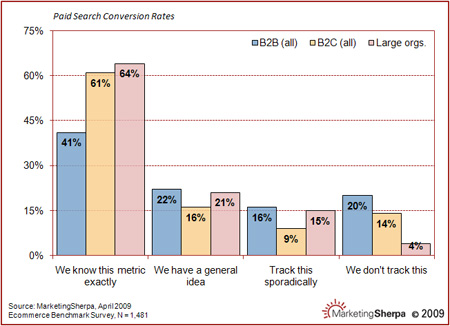
While the tall bars in the “exact knowledge” column appear reassuring, 58% of B2B companies, 39% of B2C companies and 41% of large companies do not have a precise sense of their paid search metrics. As we saw in our May 15th clinic on B2B success stories, attention to poorly performing PPC keywords (and tailoring landing pages to specific keywords) can reveal rich new sources of interested prospects.
Once you’ve optimized your search campaigns and prospects are finding you, which tactics will then encourage them to buy, or return?
Tactics that do (and don’t) work today
The next chart shows how marketers rated the effectiveness of various engagement and sales tactics, aside from dramatic price discounts.
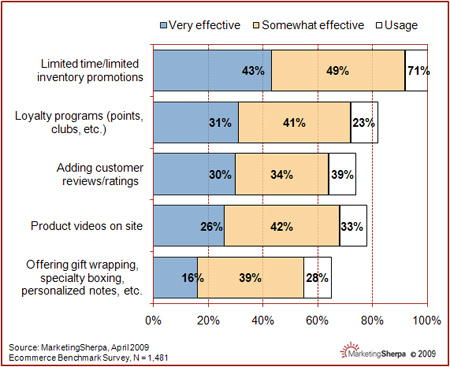
Of those surveyed, 74% reported that adding consumer reviews and product videos produced a positive response. Both of those tactics empower prospective buyers with enhanced information about their product choices and an increased feeling of connection with others, fellow customers or merchants.
In addition, loyalty programs have strong psychological power for little outlay. Frequent flyer programs are good examples of this concept. After all, 30,000 miles sounds better than a $30 discount on a plane ticket.
Marketing tactics such as loyalty programs, customer reviews, and on-site video use advances in technology and behavior tracking capability to let ecommerce sites invest in continually improving customer service and customer experience.
Summary:
Distilling the research and test results above, here are a handful of ideas and action steps you should consider to boost your ecommerce results:
- Emphasize the elements of your pages that enhance customer service and customer experience, with a special focus on prominent areas. Eyetracking or clicktracking reports can point out these areas if you’re uncertain about where to start.
- With copy, ensure that benefits are consistently, clearly expressed even in areas that sometimes are not perceived as sales or marketing communications, such as customer service areas on websites or emails for autoresponders, confirmations, receipts and transactions. This can generate return visits, add-on sales and additional revenue.
- No matter how good you are, strive to constantly improve your understanding of your key metrics and performance indicators. Knowing what to measure will lead to new opportunities for testing and potential gains.
- Review test results carefully and make an effort to go back and re-review them later. Much like proofreading copy, taking a break and returning to information with a fresh set of eyes can help you discover new avenues to improve revenue and ROI.
Related MarketingExperiments Reports:
- Optimizing eCommerce Pages
- Ecommerce Holiday Playbook
- Optimizing Offer Pages
- Marketing Blueprint 2009
- Lessons Learned
- Value Proposition
- Simple Tests, Significant Gains
- What’s Working Now in Optimization
- Email Optimization
Credits:
Managing Editor — Hunter Boyle
Writer(s) — Anna Jacobson
Contributor(s) — Stefan Tornquist
Heather Andruk
Jimmy Ellis
Adam Lapp
Bob Kemper
Austin McCraw
Aaron Rosenthal
Production — Landon Calabello
Austin McCraw
Cliff Rainer
Test Protocols:
TP 2033
TP 1223
TP 1230




